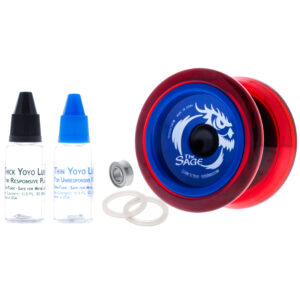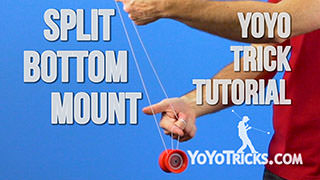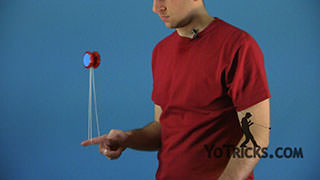Boingy-Boing Yoyo Trick Core
Left Handed?
Learn how to do the yoyo trick Boingy-Boing (or Boing-e-boing). This Split Bottom Mount trick is impressive and challenging to learn.

Boingy-Boing Yoyo Trickn this video, I am going to teach you the trick Boingy Boing, and it looks like this:
Now, Boingy Boing is one of those tricks where, the day you first decide to start learning this trick, is probably not going to be the day you feel like you have mastered it. Maybe not even the day you feel like you have hit it even once. That is because Boingy Boing, it just takes a really long time and a lot of practice to get down right. The nice thing about it is, once you have it down, it is pretty easy to execute, but just getting the motion exactly right, it take a long time. So in this video, I am going to teach you how to do the trick, but mostly, what I am doing is I am giving you all the tips that you need so that when you practice it, you are going to have the most chance of developing the right technique, without running into problems.
So the first thing that you need to do when you want to practice Boingy Boing is you want to get into the Split Bottom Mount. One of the problems that a lot of people run into as they practice the trick is that they continually miss the strings. So there is a lot of different things that you can do with the strings to make sure that they are lined up as much as they can be. The first thing is that typically when you get into a Split Bottom Mount, you have your yoyo finger bent in. What you want to do for Boingy Boing is you want to extend it and then lay the string from your yoyo finger right over the string, going over the first finger of your yoyo hand. That will make sure that all the strings can be perfectly aligned so that the yoyo can go between them.
Now, the second thing that you want to do is you want to make sure that both of your hands are perfectly aligned with one another. What I mean by that is a couple of things. The first thing you want to make sure, that your first finger on both hands are parallel to each other. You do not want them to be angled off like this. You can see that that causes the yoyo to twist and turn. It also gets the strings out of the way of the yoyo, so you are almost guaranteed to miss them if your fingers are not perfectly parallel.
The second thing is, you want to make sure that the strings for the trick are going up and down perfectly straight. So, a lot of times when you are first practicing and there is kind of that awkwardness of not knowing what to do with your hands, there is a tendency for your opposite hand to move to the outside a little bit, or for one of your hands to not be right over the other. You can see, again, that causes the yoyo to turn, it misaligns the strings.
So if you are having a lot of problems with the yoyo leaning or turning in the middle of this trick, make sure that the string is perfectly vertical by having your hands lined up. Make sure your fingers are parallel to one another, and make sure that the string coming off of your yoyo finger is laying on top of the string going over the first finger of your yoyo hand.
Once you have everything lined up, one other tip that I can give you to make it a little bit easier is, it is a good idea to set your bottom hand slightly in front of your yoyo hand. You can see that that causes a little bit of separation between the yoyo and the front string. A lot of times, people when they teach the trick, they tell you to have your hands perfectly vertical. We found that it is kind of hard to get the boings started when the yoyo is set up that way. So if you just have your bottom hand slightly in front of your yoyo hand, and again, just a little bit, then there is a little bit of room for the yoyo to actually get started with the trick.
Now, once you get better at the trick, what you can do is you can use the momentum of getting into the mount to give yourself a lot more room. You can see it swings back and then you can launch right into the mount. But that is when you get better at the trick, that is one way to approach it.
As you are practicing this trick, it should be pretty straightforward in the sense that you know that you need to pull your hands apart in order for the yoyo to go into this front string. But what may not be obvious is that you also need to bring your hands together as it hits the front string. See what happens if you are not thinking about that, you will pull your hands apart, and it will just ricochet into that top string and then kind of bounce between them. This is one of those things that makes Boingy Boing really difficult, is that it is not just an upward motion, there is also a downward motion involved as well.
So, let me show you what that looks like if you are doing the trick and you are doing really large boings like this, you can see how close my hands get together. The reason for that is, is that the further the yoyo extends into the front of the mount and also toward the back of the mount, you need to bring your hands together to give it all that room. So, again, that is just part of working on this trick. You are going to keep your bottom hand still and your top hand is going to move straight up and straight down. It is going to take a little while to figure out that balance.
Another thing that a lot of new players do, when they are first working on this trick is, instead of pulling straight up and straight down, they imagine that since the yoyo has to go front to back, they do kind of a front and back motion, which, that is so much harder to control, it does not look as good, it is a better thing to just work on being very focused on just moving your hands straight up and straight down.
Now, as you are practicing this and you are getting the up and down motion going, one thing that might happen is you might see the yoyo start to slide down the string toward your opposite hand, and this might even happen. Or, the opposite might happen, where as you are doing the boings, it might start to climb up the string and even hit your top hand. The reason why that is happening has to do with your bottom hand. As you are practicing the trick, like I already said, you want to keep your bottom hand perfectly still. If you start to bring your bottom hand up even a little bit, what will happen is the yoyo will immediately fall down into the bottom of the mount. The same thing is true if you are putting too much tension on the string by pulling your hands apart, the yoyo will start to slide up and it will eventually hit your top hand. So, the easiest thing to do is to just keep that finger still, not move it, and try to control the trick with your other hand completely.
Now, some people might tell you that if you are consistently having this problem, where the yoyo is dropping during the trick, that you should pinch the string up here, and that will keep it from dropping, but it also adds kind of an element of slack to the trick. That just complicates things, it is something that if you can just keep your bottom hand still, that will stop happening. Do not pinch the string, it just makes it more difficult than it really needs to be.
So, now that you are kind of keeping track of all of this stuff, you have got it into the mount, you have got the strings lined up, you have got the strings on top of each other on your first finger, now you are going to start practicing the trick. Chances are, like I said, you are not going to have a lot of success right away. But that is just part of the discipline of learning this trick, is you need to give yourself some time to work it out. There is going to be a lot of failures. But eventually you will get that feeling. But I want to give you a couple more things that you can do while you are practicing, just to try something else so that you can keep working on it, even when you feel like you are not having success.
So the first thing that you can do is you can actually practice this trick outside of the Split Bottom Mount. So watch this. You are in the Split Bottom Mount, and if you just pull your opposite hand out, now you are in like a Keychain mount, kind of. Watch this. If you just move your hand straight up and down, you can get that same back and forth motion with just one hand. And again, this illustrates that it is not just about pulling your hands apart, but it is also bringing your hands together. That up and down motion works, and watch this, you can actually transition right from this, if you insert your hand at just the right point, you can transition right into a boing, and then back out again. So it is the right motion, but what this illustrates is that Boingy Boing is a lot more about rhythm and timing than it is just slamming the yoyo into the strings, or it bouncing between two strings.
What I mean by that is, as you are practicing the trick, what you want is to have a consistent, steady rhythm. That is super important. What does not matter is how fast that rhythm is, or how slow it is. What matters is that it is consistent. As long as you can have that consistency, then the yoyo will kind of match the rhythm that you have, and this particular way of practicing illustrates that really well. Now, at least one of us on the YoTricks team, we learned using a completely different method. So this one is a little bit more out of the box, but I think you will see how this works. Instead of practicing your boings straight out, what you do is you just pass it in front of and then behind the first finger on your opposite hand. Again, that just serves to illustrate that it is an up and down motion, and there is a regularity to it.
But watch what happens as you practice this particular method. Eventually, you might see the yoyo start to swing, and you can see the more it swings, the more it is like the regular Boingy Boing motion. So it is a simpler method that you can try that will lead into practicing the normal trick. Now, one thing, if you are using a responsive yoyo, this particular method may end up snagging the string a little bit, it might bind when you do not want it to. So if you want to practice this method, it is a good idea to use an unresponsive yoyo, if that is happening to you. Now, the other thing is you can kind of transition using this method into like, a half boing practice. So let me show you what that looks like. Instead of going down in front on either side of your first finger, you could just do it on one side, so you go under, and then do a boing. Then you can practice that on the other side too, where you do a boing and just go down on one side.
Again, these are just kind of steps along the way so that you can continue to practice until you get that perfect rhythm down and you start to really feel the trick. Now, when you are practicing this trick, like we already mentioned, it is going to take a little while, but there is going to be that moment where you really get it, and it is going to feel different and you are going to know that you got it. So when that happens, make sure that you keep practicing because you do not want to lose it. But if you just keep at it and keep working at it, as you can see it is a really fun trick and it is really satisfying to learn. So that is Boingy Boing.







